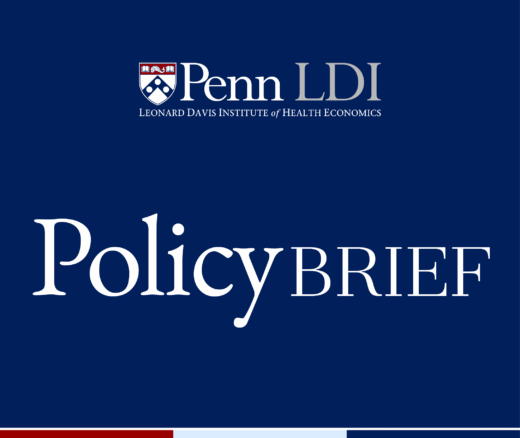
Nursing Home Incentive Program Falls Flat, New Work Explains Potential Reasons
A Major Federal Value-Based Purchasing Program Was Designed to Cut Hospital Readmissions. LDI Fellows Say the Incentives Are Too Small to Drive Real Change
Blog Post

As the world grapples with the aftermath of the COVID-19 pandemic, the migration of health care professionals has emerged as a critical issue requiring the attention of policymakers in the U.S. and across the world.
The problem lies in an imbalance in how workers are distributed, both domestically and globally. International migration to high-income countries grew steadily from fewer than 2.5 million migrants in the 1960s to over 5 million between 2010 and 2015, and it jumped more during the pandemic. The World Health Organization placed 55 countries on its most recent health workforce support and safeguards list published in 2023, up from 43 countries in 2020. Countries on this list face the most pressing health workforce challenges for achieving universal health coverage.
High-income countries like the U.S. boast well-equipped systems with lower levels of worker shortages, while low- and middle-income countries (LMICs) often face severe shortages. The African region still has the lowest density of doctors (about 2 per 10,000 population) and nursing and midwifery personnel (about 10 per 10,000 population), compared to the global median of 49 per 10,000.
The migration of health workers worsens this disparity, as professionals from LMICs are drawn to the promise of better opportunities, higher wages, and improved work conditions in wealthier nations.
Their migration acts as a brain drain that perpetuates a cycle of dependency on foreign aid and external support, hindering efforts to achieve the UN’s Sustainable Development Goals and Universal Health Coverage. Sub-Saharan Africa has spent billions of dollars to educate physicians now working elsewhere in destination countries.
Migration also can result in a brain waste phenomenon when migrant health care workers find themselves underused or relegated to lower-level positions in destination countries. This common phenomenon represents an overall loss of valuable human capital and expertise.
The 55 countries on the WHO’s 2023 workforce report are defined as those facing the most pressing workforce challenges for universal coverage. The WHO calls for prioritizing all 55 countries—ranging from Haiti and Nigeria to Pakistan and Papua New Guinea—for personnel development and system support and discouraging active international recruitment of their personnel.
The influx of foreign-trained workers has been a mixed blessing for U.S. health systems. On one hand, the migration addresses the country’s growing demand for health care services, particularly in underserved areas facing shortages of local talent. Foreign-trained physicians, nurses, and other health care professionals play a crucial role filling staffing gaps and ensuring that patients receive needed care. About one in five active U.S. physicians was born and attended medical school outside the U.S. or Canada.
However, the influx also raises questions about equity and fairness in recruitment practices. Some critics argue that wealthier nations poach talent from countries that can ill afford to lose it. Moreover, the reliance on foreign-trained workers masks underlying systemic issues within the U.S. education and training pipeline, including shortages of residency slots and limited access to higher education for domestic students.
A multifaceted approach is needed to address the challenges posed by health worker migration. First, efforts must be made to strengthen domestic workforce development, ensuring that an adequate number of professionals are being trained to meet the nation’s needs. This may involve expanding medical education programs, increasing funding for residency positions, and implementing initiatives to attract and retain health care talent in underserved areas. Meanwhile, to minimize brain waste, health care leaders must prioritize strategies for effectively integrating into the U.S. health system the foreign-trained health care workers who do migrate. Strategies could include simplifying licensure and credentialing processes and creating pathways for career advancement and professional development.
On the global stage, policymakers must work together to address the root causes of worker migration, including socioeconomic disparities, political instability, and inadequate health care infrastructure in LMICs. Initiatives that strengthen health systems and improve working conditions are essential for incentivizing professionals to remain in their home countries, reducing reliance on foreign-trained talent, and promoting sustainable development.
Given the continued trend towards globalization and persistent U.S. dependence on foreign-trained workers, efforts to strengthen global health education and training should be a strategic U.S. priority, as well as an ethical and moral priority.
International medical graduates comprised 25% of matched residency applicants in 2024. Notably, over a third of these international medical graduates were U.S. citizens, highlighting the country’s dependence on international training institutions for training its health workforce.
Understanding such dimensions of migration can lead to more proactive steps to address its underlying causes and build a more equitable and sustainable global health care workforce for the benefit of all.
The study, “Drivers of Global Health Care Worker Migration,” was published on March 7, 2024 in the Journal of the American College of Radiology. Authors include Cleverson Alex Leitão, Gabriel Lucca de Oliveira Salvador, Bukunmi Michael Idowu, and Farouk Dako.


A Major Federal Value-Based Purchasing Program Was Designed to Cut Hospital Readmissions. LDI Fellows Say the Incentives Are Too Small to Drive Real Change

Penn LDI’s Antonia Villarruel and 10 Other Authors Map Social Determinants Across Multiple Racial and Ethnic Groups

Memo: Response to Request for Analysis

Lessons from the Past, Imperatives for the Future

An LDI Expert Offers Five Cost Control Measures As Congress Continues Its Affordability Debate

A New Study of a Sample of Facilities Found Half Without Any Behavioral Health Staff